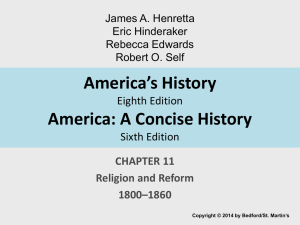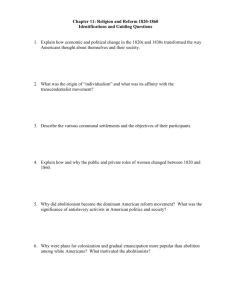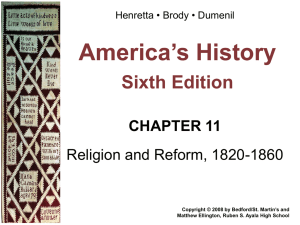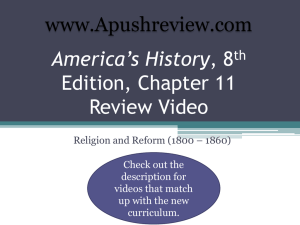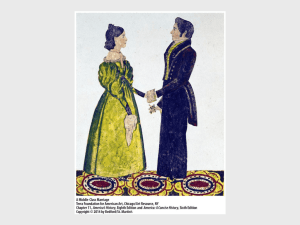America's History Seventh Edition
advertisement
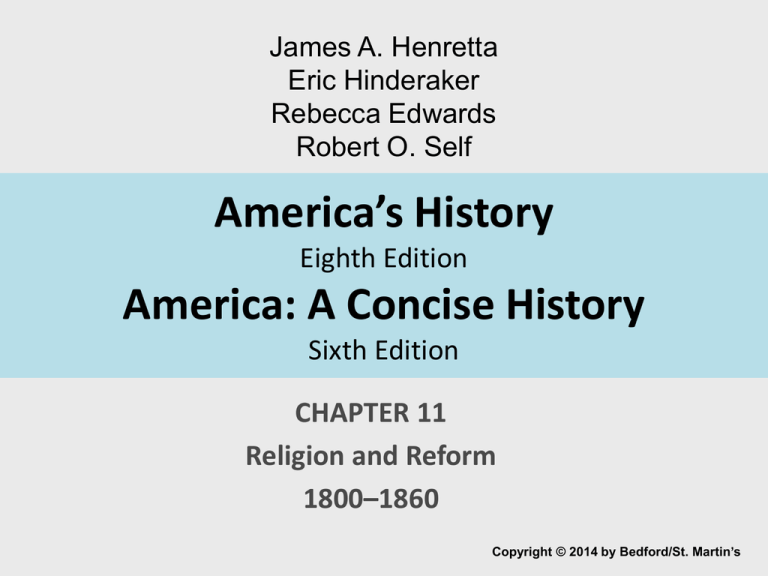
James A. Henretta Eric Hinderaker Rebecca Edwards Robert O. Self America’s History Eighth Edition America: A Concise History Sixth Edition CHAPTER 11 Religion and Reform 1800–1860 Copyright © 2014 by Bedford/St. Martin’s I. Individualism: The Ethic of the Middle Class A. Ralph Waldo Emerson and Transcendentalism 1. Transcendentalism -Rejected Enlightenment thinking. Explored “individuality.” Balance between Man, Nature, and God. 2. The lyceum movement -Way to reach people through public lectures. Fostered discussion. Attractive to middle class in North and Midwest, not the South. Emerson most popular speaker. I. Individualism: The Ethic of the Middle Class B. Emerson’s Literary Influence 1. Thoreau, Fuller, and Whitman -Thoreau lived in cabin for 2 years, published Walden, or Life in the Woods about his search for meaning in the woods. Fuller explored freedom for women. Men and women capable of a relationship with God. Women deserved Independence. Whitman: printer, teacher, journalist, newspaper editor. Writes Leaves of Grass, poems celebrating desire to break from tradition. 2. Darker Visions I. Individualism: The Ethic of the Middle Class B. Emerson’s Literary Influence 1. Thoreau, Fuller, and Whitman 2. Darker Visions -Nathaniel Hawthorne: pessimistic worldview. The Scarlet Letter criticized excessive individualism. Herman Melville: critic of transcendentalist focus on individual. Moby Dick personal quest brings death. II. Rural Communalism and Urban Popular Culture A. The Utopian Impulse 1. Mother Ann and the Shakers -Lee Ann Stanley founds Shakers, 1st American communal movement. Believed sexual lust had been downfall of Adam and Eve. “Shakers” dance during service. Disdain for intercourse led to conversation and adoptions of orphans to increase numbers. 1900 they virtually disappeared. 2. Albert Brisbane and Fourierism II. Rural Communalism and Urban Popular Culture A. The Utopian Impulse 1. Mother Ann and the Shakers 2. Albert Brisbane and Fourierism -Charles Fourier predicted decline of individual property rights + capitalist values. Leading disciple Albert Brisbane believed socialism would liberate workers from capitalist employers. Phalanxes would own property in common. Liberation in women and men. Founded cooperatives in w. NY and midwest. Most collapsed. II. Rural Communalism and Urban Popular Culture A. The Utopian Impulse (cont.) 3. John Humphrey Noyes and Oneida -Noyes: Charismatic and religious. Rejected marriage. Embraced “complex marriage” where all members of community are married to one another. Rejected monogamy (women free from status of property to husband). Females cut hair short + wore pantaloons. Founded community near Oneida. 200 residents. Noyes fled to Canada to avoid prosecution for adultery. Community abandoned complex marriage. Retained cooperative spirit. II. Rural Communalism and Urban Popular Culture B. Joseph Smith and the Mormon Experience 1. Joseph Smith -Book of Mormon: ancient civ. Migrated west + visited by Christ after Resurrection. Encouraged patriarchy, frugality, hard work, church directed society. Revelation justified polygamy. Charged with treason (believed trying to build community in Mexico). Murdered in jail. 2. Brigham Young and Utah -Led disciples. Settles in UT. Young named governor in 1850/ Led short “Mormon War” over issue of polygamy + possible nullification. II. Rural Communalism and Urban Popular Culture C. Urban Popular Culture 1. Sex in the City -Pop. Growth in cities = new urban culture. Rural men+women go to cities and find life difficult. Low wages for men. Women working domestic jobs sexually exploited. Sex for $ common (mistresses + “bawdy houses” Prostitutes advertised in open. No parents to control daily lives. 2. Minstrelsy 3. Immigrant Masses and Nativist Reaction II. Rural Communalism and Urban Popular Culture C. Urban Popular Culture 1. Sex in the City 2. Minstrelsy -Rat+ Terrier fights and traditional theater popular. Minstrel shows with blackface common. John Dartmouth Rice’s character “Jim Crow” famous in NY. Also stereotyped Irish drinking alcohol. Made fun of womens rights activists + elite white men. 3. Immigrant Masses and Nativist Reaction II. Rural Communalism and Urban Popular Culture C. Urban Popular Culture 1. Sex in the City 2. Minstrelsy 3. Immigrant Masses and Nativist Reaction -Immigrants want to be viewed as white. Irish join American Catholic Churches + join Democratic Party. Nativists want to stop immigration. Gangs form in NYC. Violence between immigrant groups + native born whites. III. Abolitionism A. Black Social Thought: Uplift, Race Equality, and Rebellion 1. David Walker’s Appeal -N. free blacks focus on social uplift. White mobs attack blacks in N. cities. Walkers (free black from NC, self educated) writing respond to attacks. Ridiculed religious arguments of slaveholders. Justified rebellion. Convention for free black leaders in Philadelphia demanded race equality. 2. Nat Turner’s Revolt III. Abolitionism A. Black Social Thought: Uplift, Race Equality, and Rebellion 1. David Walker’s Appeal 2. Nat Turner’s Revolt -Slave in VA separated from wife has religious vision. Led revolt killing 55 whites. Caught and hanged. VA increased slave codes, prohibited teaching to slaves to read, limited black movement in state. III. Abolitionism B. Evangelical Abolitionism 1. William Lloyd Garrison, Theodore Weld, and Angelina and Sarah Grimké -Garrison founded New England Anti-Slavery Society. Published The Liberator. Appealed to religious people. Weld published Bible Against Slavery. Grimke + Weld American Slavery as It Is: Testimony of a Thousand Witness 2. The American Anti-Slavery Society -”Great Postal Campaign” sent over a million pamphlets. Urged fugitive slaves to tell their story. Established Underground Railroad. III. Abolitionism C. Opposition and Internal Conflict 1. Attacks on Abolitionism -Movement was minority. Slaveholders attack movement. Many oppose “amalgamation” or racial mixing. N. Whites attack churches, temperance halls, homes, etc. of abolitionists. 2. Internal Divisions -w/ in movement activists disagree. Some oppose Garrison’s support for women’s rights. They form American and Foreign Anti-Slavery Society. IV. The Women’s Rights Movement A. Origins of the Women’s Movement 1. Moral Reform -Religious women wanted to help other women. Female Reform Society aims to curb prostitution + protect single women from moral corruption. 2. Improving Prisons, Creating Asylums, Expanding Education -Dorothea Dix wanted to save children from vice. Campaigned to improve care for mentally ill. Started asylum building movement to separate mentally ill from criminals. Horace Mann and many women support school movement. IV. The Women’s Rights Movement B. From Black Rights to Women’s Rights 1. Abolitionist Women -Central to anti-slavery movement. Harriet Jacobs Incidents in the Life of a Slave Girl describes forced sexual relations w/ her master. Harriet Beecher Stowe Uncle Toms Cabin: sex abuse of women is moral failing of slavery. Grimke sisters attack slavery + claim women should have equal rights. Abolitionist women claim traditional gender roles = domestic slavery of women. 2. Seneca Falls and Beyond IV. The Women’s Rights Movement B. From Black Rights to Women’s Rights 1. Abolitionist Women 2. Seneca Falls and Beyond -Women’s rights activists demand stronger legal rights for women (property ownership: MI, ME, MA, NY adopt). Elizabeth Cady Stanton + Lucrieta Mott organize Seneca Falls Convention. 70 women 30 men attend. “Declaration of Sentiments” made claim for women in public life + criticized idea of “separate spheres” (women’s place is in home as mother/wife). 1851 began effort to gain voting rights. Susan B. Anthony leads movement.
